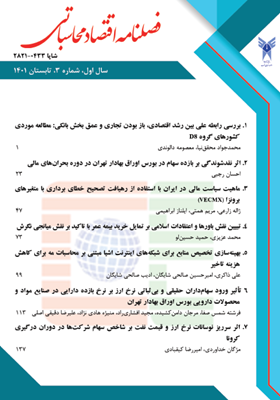ماهیت سیاست مالی در ایران با استفاده از رهیافت تصحیح خطای برداری با متغیرهای برون زا (VECMX)
محورهای موضوعی : فصلنامه اقتصاد محاسباتیژاله زارعی 1 * , مریم همتی 2 , ایلناز ابراهیمی 3
1 - عضو هیأت علمی پژوهشکده پولی و بانکی
2 - استادیار گروه مطالعات پولی و ارزی پژوهشکده پولی و بانکی بانک مرکزی
3 - استادیار گروه مطالعات پولی و ارزی پژوهشکده پولی و بانکی بانک مرکزی
کلید واژه: سیاست مالی, چرخههای تجاری, مخارج مصرفی بخش خصوصی,
چکیده مقاله :
در این تحقیق ماهیت سیاست مالی ایران در چرخههای تجاری در دوره زمانی ۱۳۷۰-۱۳۹۹ با تواتر فصلی ارزیابی گردیده است. برای این منظور، از الگوی تصریح شده هریستوف (۲۰۱۳) استفاده شده که با توجه به وابستگی اقتصاد ایران به درآمدهای نفتی، تعدیلاتی در آن اعمال شده و سری زمانی درآمدقابلتصرف و مخارج مصرفی بخش خصوصی از دادههای بودجه خانوار که توسط مرکز آمار ایران منتشر میشود، استخراج شده است. همچنین برای محاسبه تکانه مخارج، درآمدهای مالیاتی و نفتی، از رویکرد VECMX استفاده شده است. نتایج نشان داد که مخارج دولت در دورههای رونق و رکود اقتصادی اثر مثبت و معنیداری بر رشد مخارج مصرفی بخش خصوصی دارند بهعبارتی سیاست مالی در ایران ماهیت کینزی دارد. اما شدت اثرات تکانههای مخارج دولت بر رشد مخارج مصرفی بخش خصوصی در دورههای رونق بیشتر از دورههای رکود میباشد. همچنین تعداد وقفههای اثرگذاری تکانههای مخارج دولت بر رشد مخارج مصرفی بخش خصوصی در دوره رونق و رکود متفاوت بوده و این میزان در دوره رکود بیشتر است. علاوه بر این، ارزیابی سایر متغیرهای سیاست مالی گویای آن است که تکانههای درآمدهای مالیاتی بر رشد مخارج مصرفی بخش خصوصی در چرخههای تجاری معنیدار نبوده است و تکانههای درآمدهای نفتی نیز با چهار وقفه فقط در دوره رونق مثبت و معنیدار میباشد.
In this research, the nature of Iran's fiscal policy has been evaluated in business cycles in the period of 1999: Q2- 2021:Q1. For this purpose, the specified model of Hristov (2013) has been used, in which adjustments have been applied due to the dependence of Iran's economy on oil revenues, and the time series of disposable income and consumption of the private sector from the household budget data published by the Iranian Statistics Center. , has been extracted. Also, the VECMX approach has been used to calculate the momentum of expenditures, tax and oil revenues. The results showed that the government spending in periods of economic boom and recession have a positive and significant effect on the growth of private sector consumption, in other words, fiscal policy in Iran is Keynesian in nature. But the intensity of the effects of government expenditure impulses on the growth of private sector consumption e is greater in periods of prosperity than in periods of recession. Also, the number of interruptions in the impact of government expenditure impulses on the growth of private sector consumption is different in the period of prosperity and recession, and this amount is more in the period of recession. In addition, the evaluation of other fiscal policy variables shows that the impulses of tax revenues on the growth of private sector consumption were not significant in business cycles, and the impulses of oil revenues are also positive and significant with four interruptions only in the period of prosperity.
_||_

